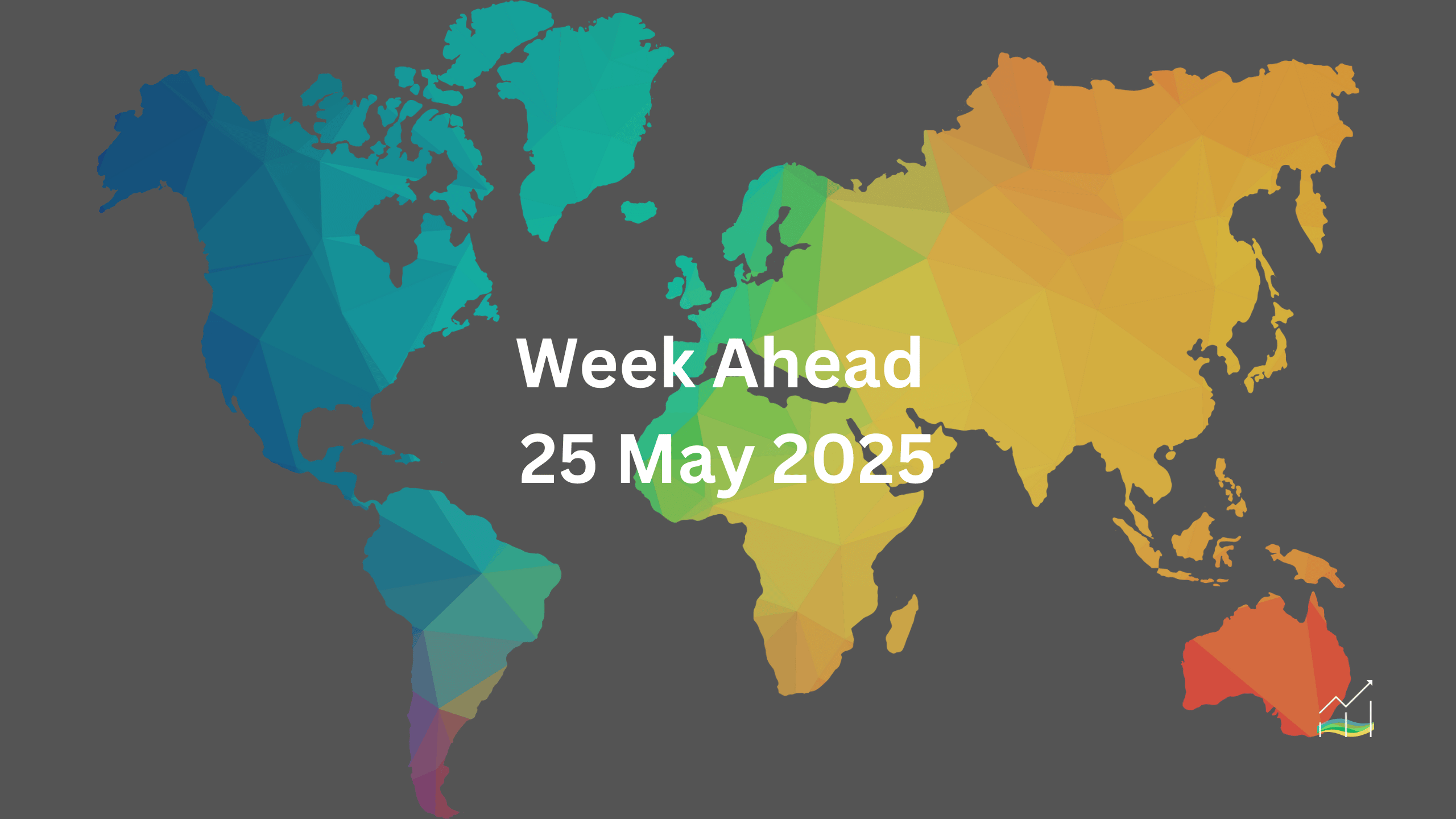25/05/2025 Week Ahead

Intensifying U.S. Trade Conflict & Rising Bond Yields
Key Takeaways:
- US trade tensions escalate significantly, with Trump proposing steep tariffs against Europe.
- Markets respond negatively; Europe's Stoxx 600 suffers major losses.
- Currency markets volatile; euro rebounds, while Pound, CAD, Peso, and Yuan hit annual highs.
- Bond yields continue climbing sharply in the US and Japan, driven by inflation concerns and interest rate expectations.
The United States intensified global market volatility with its latest moves on tariffs and fiscal policies. President Trump escalated trade tensions significantly by accusing the European Union of bad-faith negotiations, threatening severe tariffs of up to 50% effective June 1. The proposed measures against the EU are more aggressive than those recently levied on China, further unsettling investor sentiment. Additionally, Trump has signalled the possibility of a 25% tariff specifically targeting smartphones from Apple and Samsung, exacerbating market uncertainty.
European markets reacted negatively, with the Stoxx 600 index experiencing its steepest decline since April. This turmoil spilled over into global currencies, briefly dragging down the euro before it rebounded strongly, ultimately closing 0.7% higher for the session and recording its first weekly gain in over a month. In contrast, currencies like the British pound, Canadian dollar, Mexican peso, and Chinese yuan each hit fresh yearly highs, highlighting shifts in global investor preferences amid heightened risk.
The bond markets of the US and Japan also continued their upward trajectory, reflecting ongoing inflation pressures and changing central bank expectations. In Japan, yields for 30-year bonds rose to 3.05%, marking their fourth consecutive weekly increase, while yields for 40-year bonds surged to 3.55%, their highest in recent months. Inflation indicators supported these movements, with Japan reporting an April CPI rate of 3.6%.
In the US, long-term treasury yields followed suit, with the 10-year yield increasing by around 25 basis points to approximately 4.50%, and the 30-year yield climbing around 35 basis points to above 5.0%. These significant rises are largely attributable to shifting market expectations around the Federal Reserve’s rate policy, evidenced by a nearly 40-basis-point increase in the implied overnight rate in Fed funds futures over the past month.
Investors now face heightened volatility as the interplay of trade disputes, inflation dynamics, and shifting monetary policy stances continues to reshape market landscapes worldwide.
United States of America
Overview
The US dollar struggled despite expectations that the Federal Reserve’s next rate cut might be delayed until the fourth quarter. Markets are adjusting to an environment of persistent uncertainty, often referred to as "strategic ambiguity." This uncertainty has driven investors to require higher interest rate premiums to justify holding the dollar, weakening its appeal overall.
The coming week will be eventful, with numerous important economic data releases scheduled. The Federal Reserve has indicated a preference for real economic indicators rather than surveys, noting that real sector figures have remained relatively stable compared to softer survey data. This implies that while survey results will be noted, real sector data will likely have greater impact on market perceptions and policy expectations.
Key data releases include April's durable goods orders and personal income and consumption figures. Notably, durable goods orders will likely face downward pressure from a sharp decline in Boeing aircraft orders, significantly lower than the previous month. Personal income and spending reports will contribute significantly to GDP forecasts for the second quarter, while inflation metrics such as the core PCE deflator are expected to remain steady at around 2.6% year-over-year.
Economic Drivers
- Market expectations shifting Fed rate cuts further into the future (Q4 2025).
- Elevated market uncertainty ("strategic ambiguity") is causing investors to seek higher interest rate premiums for dollar holdings.
- Ongoing geopolitical risks from intensified US-EU trade tensions, including President Trump's proposed tariff hikes.
Data and Events
- 26 May 2025: Fed Chair Powell Speaks.
- 27 May 2025: Durable Goods Orders.
- 27 May 2025: CB Consumer Confidence.
- 28 May 2025: FOMC Members Speak.
- 29 May 2025: FOMC Meeting Minutes.
- 29 May 2025: Prelim GDP.
- 29 May 2025: Unemployment Claims.
- 29 May 2025: Pending Home Sales.
- 30 May 2025: Core PCE Price Index.
- 30 May 2025: Revised UoM Consumer Sentiment.
Price Action
- The Dollar Index hit a new monthly low slightly below 99.00, later stabilizing briefly on tariff news.
- Resistance emerged near the 99.60 level, with the index closing the week down nearly 2%, ending a four-week rally.
- Momentum indicators are trending downward, and a bearish crossover (five-day below 20-day moving average) occurred.
- Technical support near 98.85 is crucial; breaking this level could lead to retesting April's three-year low around 98.00.
Key Points:
- Increased uncertainty weighing on dollar demand.
- Real sector economic data to overshadow surveys.
- Durable goods orders impacted by declining Boeing orders.
- Core inflation likely stable at 2.6% year-over-year.
- Technical momentum negative; watch support at 98.85.
Australia & New Zealand
Overview
The Reserve Bank of Australia (RBA) followed through on market expectations by lowering its cash target rate by 25 basis points last week. Although another rate cut is anticipated, market consensus strongly suggests that the next reduction will come in August rather than at the July meeting. This forecast diminishes the immediate market impact of upcoming economic data, with the RBA placing greater emphasis on quarterly inflation data rather than monthly metrics.
Domestic economic signals remain mixed, with consumer demand showing signs of slowing down. Retail sales growth in the first quarter moderated significantly, advancing at an annualized rate of 3.6%, down notably from 4.8% in the same period last year. Conversely, private credit growth stayed relatively stable, holding steady around a 5.8% annualized pace. These indicators highlight a cautious consumer sentiment alongside steady credit market activity.
In addition, market dynamics for the Australian dollar (AUD) are increasingly influenced by broader global risk appetite and US dollar trends, particularly in relation to the Canadian dollar. Over recent months, the AUD has shown notable correlation with both the US equity market (S&P 500) and China’s CSI 300 index, reflecting its sensitivity to global economic conditions and investor sentiment.
Separately, the Reserve Bank of New Zealand (RBNZ) is set to meet this week and is expected to lower its benchmark rate by 25 basis points to 3.25%. This continued easing cycle, initiated last August from 5.50%, may indirectly affect market sentiment and outlook for monetary policy in Australia.
Economic Drivers
- RBA's recent rate cut of 25 basis points; next cut widely anticipated in August.
- High correlation of the Australian dollar with US equity indices (S&P 500) and China’s CSI 300, indicating sensitivity to global risk sentiment.
- Slowing consumer spending trends in Australia, indicating weakened domestic demand.
- Upcoming RBNZ rate cut potentially influencing market sentiment across the region.
Data and Events
- 28 May 2025: AUD CPI.
- 28 May 2025: NZD Official Cash Rate.
- 28 May 2025: RBNZ Monetary Policy & Rate Statement.
- 28 May 2025: RBNZ Press Conference.
- 30 May 2025: AUD Retail Sales.
Price Action
- AUD/USD rebounded strongly after testing support near $0.6400, recovering to approach $0.6500.
- Successfully closed above key resistance around the descending trendline at $0.6485, signaling a constructive outlook.
- Momentum indicators and moving averages indicate potential further upside.
- Immediate resistance lies at $0.6515, with a successful break targeting $0.6550 next.
Key Points:
- Next RBA rate cut expected in August, not July.
- Domestic consumption weakening; credit growth stable.
- AUD strongly correlated with global market sentiment.
- Technical setup favors bullish continuation towards $0.6550.
Canada
Overview
The Canadian dollar has recently shown increased sensitivity to broader US dollar movements, rather than oil prices or risk sentiment. This sensitivity has intensified, with the correlation between the Canadian dollar and the US Dollar Index reaching its highest level this year at approximately 0.72. Interestingly, while typically inversely related to risk assets such as the S&P 500, the Canadian dollar has recently exhibited a positive correlation, a shift last seen briefly in late 2021.
Economic data coming up this week includes Canada's GDP figures for March and the first quarter. Predicting quarterly GDP growth from monthly data has proven challenging previously. For example, despite modest monthly GDP gains in Q4 2024, quarterly growth was reported notably higher due to annualized adjustments. So far this year, GDP expanded by 0.4% in January before shrinking slightly in February by 0.2%. Market forecasts indicate the first-quarter GDP will come in around 1.8%.
These economic releases may significantly influence expectations regarding monetary policy. Following elevated underlying core inflation data, markets have drastically reduced their expectations for a near-term Bank of Canada rate cut. The probability of a rate reduction at the upcoming June 4 meeting has dropped sharply from almost 60% at the end of April to approximately 25% currently. The market now anticipates a higher year-end target rate near 2.40%, an increase from previous expectations around 2.20%.
Economic Drivers
- Strong correlation between the Canadian dollar and US Dollar Index (highest correlation this year).
- Reduced sensitivity to oil prices and domestic short-term interest rate fluctuations.
- Shift in typical correlation with risk sentiment (S&P 500), becoming positively correlated for the first time since late 2021.
- Market expectations now suggest reduced likelihood of a Bank of Canada rate cut following persistently high core inflation.
Data and Events
- 30 May 2025: GDP.
Price Action
- Canadian dollar strengthened following US tariff threats against the EU, pushing USD/CAD sharply lower.
- USD/CAD dropped from around 1.3830 to a fresh seven-month low near 1.3710.
- Technical indicators, including momentum and moving averages, suggest further downside potential.
- Key support near 1.3700; break below this level could initially target 1.3600, with deeper support around last September’s low at 1.3420.
Key Points:
- Canadian dollar highly influenced by broad US dollar trends.
- GDP release key for shaping monetary policy expectations.
- Rate cut expectations sharply reduced due to high core inflation.
- Technical momentum favors additional Canadian dollar strength toward 1.3600 and possibly 1.3420.
China
Overview
China continues its cautious management of the yuan, guiding the currency to its strongest levels against the US dollar this year. Despite the controlled appreciation, the yuan has seen relatively modest gains compared to its regional counterparts. The onshore yuan has risen approximately 1.7% year-to-date, while the offshore yuan has strengthened by around 2.3%. This careful currency management reflects China’s ongoing strategy to balance competitiveness with economic stability.
The People's Bank of China (PBOC) has recently eased monetary policy to support economic activity, although analysts question whether current efforts are sufficient without additional fiscal measures. Achieving the government's 5% annual growth target remains challenging under present conditions, highlighting concerns about the broader economic outlook.
Upcoming economic data includes industrial profit figures, which historically tend to be modest in China despite the country's manufacturing dominance. Chinese enterprises typically prioritize long-term market share growth rather than short-term profit maximization, contrasting significantly with Western businesses that are often driven by quarterly financial expectations.
Additionally, China's May Purchasing Managers' Index (PMI) report, scheduled for release at the end of the week, will offer fresh insights into the current economic environment and the momentum of manufacturing activity.
Economic Drivers
- Yuan's appreciation actively managed by authorities; relatively modest gains compared to other Asian currencies.
- Monetary easing by the PBOC aimed at supporting growth, yet limited fiscal stimulus remains a constraint.
- Difficulty achieving China's 5% GDP growth target without stronger fiscal action.
- Corporate focus on market share and long-term stability over short-term profitability.
Data and Events
- 28 May 2025: CB Leading Index.
- 31 May 2025: Manufacturing & Non-Manufacturing PMI.
Price Action
- US dollar weakened against the yuan, reaching new six-month lows around CNH7.1700 (offshore).
- Technical support next around CNH7.1460-CNH7.1500 if weakness persists.
- The onshore yuan strengthened for the fifth consecutive week, nearing CNY7.1800.
- Break below CNY7.1800 targets the next support at approximately CNY7.1380-CNY7.1400.
Key Points:
- Yuan strengthening modestly, closely managed by authorities.
- PBOC easing insufficient without additional fiscal stimulus.
- Industrial profits typically weak; corporate strategy favors market share over immediate profits.
- US dollar downtrend against yuan continues, with critical technical levels approaching.
Europe
Overview
Europe continues to attract strong interest from investors diversifying away from US dollar assets. This trend is highlighted by the significant positioning in the futures markets, where speculators currently hold their largest net-long euro positions since September last year. This renewed confidence indicates a bullish sentiment toward the euro, particularly visible during recent pullbacks, where buying support emerged strongly around the key retracement area of $1.1050.
The eurozone will release several important economic indicators this week, with particular focus on inflation data. Initial reports include confidence surveys and retail sales data from Germany and Spain, along with consumer spending figures from France. However, the main market focus will be the inflation readings from the four largest economies within the eurozone, ahead of the aggregated euro area CPI report due early in June.
These CPI figures are especially crucial given the ongoing speculation surrounding the European Central Bank’s (ECB) monetary policy direction. Unless the data significantly deviates from expectations, markets widely anticipate another rate cut from the ECB at its meeting scheduled for June 5.
Meanwhile, the euro registered its first weekly gain in over a month despite facing external headwinds, notably President Trump's threat of imposing a 50% tariff on EU imports. Although initially pressuring the euro down toward $1.1300, buyers quickly re-entered the market, supporting a recovery.
Economic Drivers
- Continued diversification away from US dollar assets boosting euro demand.
- Speculative positioning strongly bullish on euro futures, reaching highest levels since late 2024.
- Market expectation of further ECB rate cuts, pending upcoming inflation data.
- External geopolitical pressures, including US-EU trade tensions, impacting short-term market sentiment.
Data and Events
- 26 May 2025: ECB President Lagarde Speakers.
- 30 May 2025: German Retail Sales.
- 30 May 2025: German Prelim CPI.
- 30 May 2025: Spanish Flash CPI.
- 30 May 2025: Italian Prelim CPI.
Price Action
- Euro achieved first weekly gain since mid-April, facing initial resistance near $1.1380.
- Recovery supported by strong buying near critical support at $1.1300 following US tariff threats.
- Positive technical signals including bullish moving average crossover and constructive momentum indicators.
- Key resistance at $1.1380; a break higher would open targets toward $1.1575 and potentially $1.1685.
Key Points:
- Euro benefits from portfolio diversification away from the dollar.
- Inflation data crucial ahead of anticipated ECB rate cut.
- Strong speculative buying providing underlying euro support.
- Technical outlook positive with significant resistance at $1.1380.
Japan
Overview
The Japanese yen continues to closely track movements in the US dollar, demonstrating significant sensitivity to shifts in US yields and broader dollar trends. Recently, the yen’s correlation with US short-term yields has risen to the upper end of its historical range. Notably, the yen’s correlation with changes in the Dollar Index reached exceptionally high levels not seen since the mid-1990s, indicating that the currency remains heavily influenced by overall US dollar sentiment rather than solely by domestic factors.
After Japan’s GDP contracted slightly in the first quarter, attention has shifted toward second-quarter economic performance. Upcoming releases of key economic indicators, including employment figures, retail sales, and industrial production data for April, will offer essential insights into the trajectory of the Japanese economy and help shape market expectations for GDP growth in Q2.
However, inflation data from Tokyo for May will likely be more influential for setting expectations regarding future Bank of Japan (BOJ) policy moves. The prior month's inflation reading was notably elevated, driven by several one-off factors, such as the start of a new fiscal year, the expiration of school tuition waivers, and unexpected rent hikes. Market participants will closely watch whether these pressures persist, influencing monetary policy expectations moving forward.
The yen has shown resilience lately, strengthening considerably against the dollar. Over the past two weeks, the yen gained about 4%, breaking the dollar’s four-week upward trend and approaching significant technical support areas that, if breached, could signal further appreciation.
Economic Drivers
- High sensitivity of yen to US short-term yields and overall dollar direction.
- Recent contraction in Japan’s GDP putting increased focus on upcoming Q2 data.
- Inflation trends in Tokyo crucial for anticipating Bank of Japan's monetary policy decisions.
Data and Events
- 27 May 2025: BOJ Core CPI.
- 29 May 2025: Consumer Confidence.
- 30 May 2025: Tokyo Core CPI.
- 30 May 2025: Unemployment Rate.
- 30 May 2025: Prelim Industrial Production.
- 30 May 2025: Retail Sales.
- 30 May 2025: Housing Starts.
Price Action
- Yen strengthened significantly against the US dollar, with USD/JPY declining by approximately 4% recently.
- USD/JPY tested critical support near monthly lows around JPY142.35.
- Momentum indicators turned bearish, confirmed by the 5-day moving average crossing below the 20-day moving average.
- Key support now at JPY142.00, with deeper support potentially at JPY140.00, previously tested but not decisively breached.
Key Points:
- Yen highly correlated with US dollar movements.
- Upcoming inflation data crucial for BOJ policy outlook.
- Recent economic indicators will shape GDP expectations.
- Technical indicators support further yen appreciation toward JPY140.00.
United Kingdom
Overview
The UK economy finds itself at a crossroads, navigating better-than-expected growth and rising inflation amid persistent uncertainties. The first quarter GDP growth of 0.7% and elevated April CPI figures appear to provide flexibility to the Bank of England (BoE) regarding future interest rate cuts. However, both indicators likely exaggerate the underlying strength, with moderation in growth and inflation anticipated in the coming months, which will present a challenging environment for Chancellor Reeves heading into fiscal planning later this year.
Political dynamics also complicate the UK's economic outlook. Prime Minister Starmer's recent political maneuvers, particularly on immigration, have seen his popularity decline to new lows, adding to domestic uncertainties. Additionally, Starmer's administration recently secured a limited trade agreement with the US that allows specific vehicle exports but at the cost of some national autonomy, drawing criticism domestically.
Efforts to recalibrate the UK's relationship with the European Union through increased cooperation on defense and security have faced accusations of selective engagement, complicating UK-EU relations further. Meanwhile, recent US threats to impose hefty tariffs on EU imports could indirectly benefit UK competitiveness, though a weakened EU would ultimately be disadvantageous to the UK’s broader economic interests.
Despite this backdrop, sterling showed resilience. Boosted by firm core inflation figures, rising services inflation, and robust retail sales, the pound reached its highest level against the US dollar since February 2022, approaching $1.35. Yet its gains relative to the euro were relatively muted, reflecting broader market caution.
Economic Drivers
- UK growth and inflation stronger than expected in the short term, although likely overstated.
- Political pressures mounting on Prime Minister Starmer, affecting broader economic sentiment.
- UK-US limited trade deal offers some benefit at a sovereignty cost.
- Complicated and strained relations with the EU amid US tariff threats against Europe.
- Higher year-end base rate expectations, influencing monetary policy outlook.
Data and Events
- 27 May 2025: BRC Shop Price Index
- 27 May 2025: CBI Realized Sales.
- 30 May 2025: BOE Gov Bailey Speaks.
Price Action
- Sterling rose significantly against the dollar to nearly $1.35, highest since early 2022, driven by stronger UK economic data.
- Technical momentum remains bullish, with moving averages supportive of further gains.
- Next major resistance level in GBP/USD around $1.3630-$1.3650.
- Sterling recovered against the euro, pushing EUR/GBP down nearly 4% since mid-April; key euro support near 200-day moving average at GBP0.8385.
Key Points:
- Short-term economic strength likely overstated, moderation expected.
- Political and trade uncertainties influencing market sentiment.
- Sterling’s recent strength driven by positive economic data and rising rate expectations.
© 2025 SKONE Enterprise (003319453-V). All rights reserved.
The content on this site is for informational purposes only and does not constitute financial advice.


